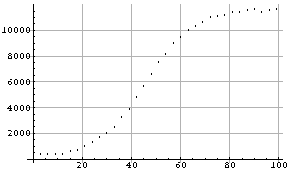
28 January 1998
Independent Mathematical Contractors, Inc.
Suite 2, Strawmarket Business Plaza
Lonlinc, SK 04685
Dear IMC:
As you undoubtedly know, EcoSystems (Inc.) is a thriving company founded to bring ecologically sound farm-raised fish to the scenic Leseatt area of Tonwashing in our bright blue environmentally friendly delivery vans. After a foray into fish production in the midwest, we have sensed a burgeoning market in the area of similarly conscientious coffee production, and have therefore purchased a small coffee-growing island in the Pacific. To our dismay, however, this has been beset by horrible coffee-plant eating insects, with which we must now deal in accordance to the environmentally conscious tenets of our company.

|
| Figure 1: Toad population |
We therefore need to know if following release of this number of toads the population on the island will exceed what we consider the critical value of 150,000. If this is the case we would like to know as accurately as possible when this will occur, in support of which calculation we would like to have an expression giving the toad population as a function of time. Finally, if it should be the case that releasing a number close to 2000 would result in a final toad population near 150,000, we would like to know how many toads should be released in that case.
As the production on the island is crippled while we wrestle with this crucial toad question, we would like your response in rather short order---your final report should be submitted by the 16th of February. To facilitate this, we have arranged with a great friend and patron of ours, the mathematically-inclined Dr. Gavin LaRose, to serve as a liason between our company and your team and to field any questions you may have in the course of your work. Please note that you must contact him as a team with some indication of your progress by the 2nd of February and again by the 9th of February. Failure to meet any of these deadlines will be grounds for partial or complete reduction in your compensation for the project. Dr. LaRose is also able to provide you with example formats which may assist in the formulation of your 3--5 page final report.
We look forward to hearing from you.
Sincerely
"Chuck" R.D. Arwin
President, EcoSystems, Inc.
crda:glr